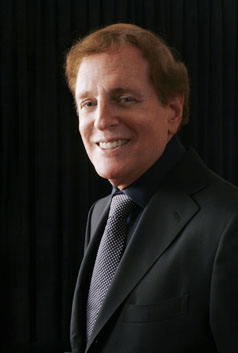

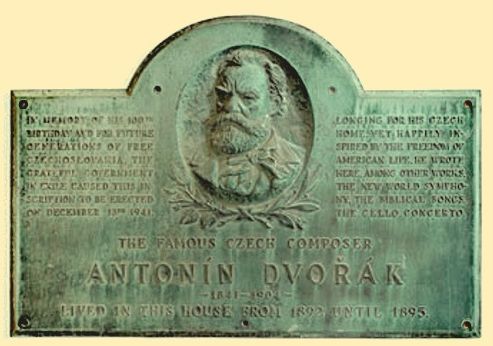
December 13, 1941 – Dedication ceremony at Dvořák House on East 17th Street honors his 100th birthday. Plaque mounting and speeches by Jan Masaryk and Mayor LaGuardia. Pianist Rudolf Firkušný and Metropolitan Opera star Jarmila Novotná perform Biblical Songs, composed in the house. Harry Burleigh and Josef Kovařík, Dvořák's former assistants, attend. |
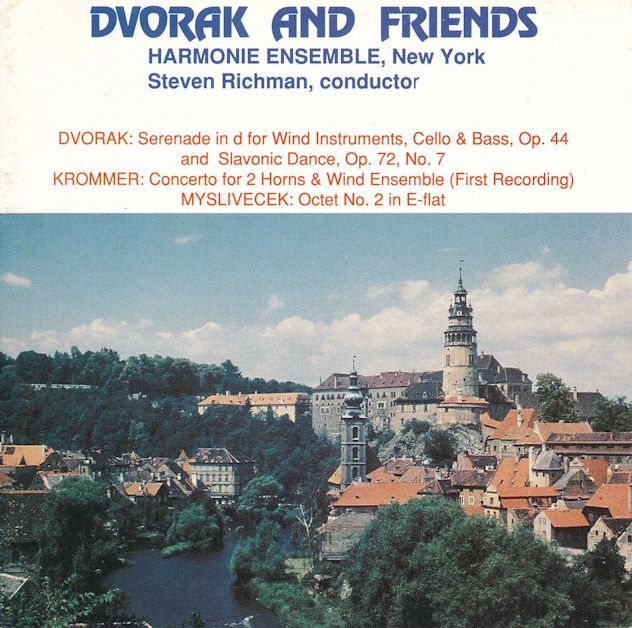 Fritz Kreisler was there, Bruno Walter was there, Harry
Burleigh, the famous black baritone and composer was there...
Fritz Kreisler was there, Bruno Walter was there, Harry
Burleigh, the famous black baritone and composer was there...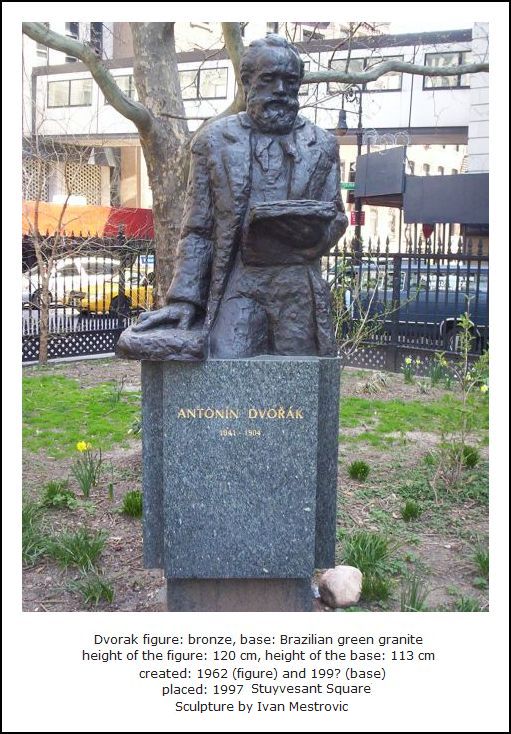 SR: The plaque is, I believe, in the
possession of the Czech Ambassador to the United Nations. The Ambassador’s
residence happens to be on Madison Avenue in the 80s in New York.
We do have access to that. Actually, I believe it was my idea...
I don’t want to take the whole credit for this, but I said they
must get this and save it. I believe they also got the mantelpiece
from Dvořák’s fireplace, which still existed, so we do have
that.
SR: The plaque is, I believe, in the
possession of the Czech Ambassador to the United Nations. The Ambassador’s
residence happens to be on Madison Avenue in the 80s in New York.
We do have access to that. Actually, I believe it was my idea...
I don’t want to take the whole credit for this, but I said they
must get this and save it. I believe they also got the mantelpiece
from Dvořák’s fireplace, which still existed, so we do have
that.  SR: Right, my current Messianic calling.
For the first concert I had been in touch with a musician in Europe
because I had found out about the existence of what we believe to be
the original version of Dvořák’s String Serenade.
The work was composed in 1875, however there was a work called Octet
Serenade, which Dvořák wrote in 1873, which is either lost
or destroyed. It is believed to be the original version of the String
Serenade. I had heard about this work a couple of years before
we started the efforts for the statue, and I’d been in touch with English
musicologist Nicholas Ingman. I was trying to find the right situation
and occasion to perform this work, as it had not been performed.
I suddenly got the idea that maybe we could use this as the centerpiece
of a benefit concert to raise money for the statue. Around the same
time, I was in contact with the late great Czech pianist Rudolf Firkušný,
who lived in New York, and he had told us that he would do anything for the
statue. I asked if he would like to play some solo piano music.
There isn’t a great deal of solo piano music by Dvořák, and it’s
not that well known. He said no, he wanted to do the A Major Piano
Quintet with the Guarneri Quartet. I gulped, and asked him if he
would speak to them. He said no, I should call them up. It just
so happens that Arnold Steinhardt, the first violinist in the Guarneri Quartet,
happens to live two blocks from me in New York — which
is not saying anything, because I live on the upper west side of Manhattan
where all the musicians apparently live when they aren’t anywhere else.
So I called Mr. Steinhardt. He’s a wonderful, charming man, as everybody
knows, and he was very enthusiastic about it. So those two pieces
were the beginning of this recording. The Dvořák Discovery
CD actually has the live concert performance of the Octet Serenade.
It does not have the Quintet because it would not fit. It’s
a very long piece. Another work that is on the CD, which is the other
of the major discoveries, is an arrangement that we found that Dvořák
did a month after the premiere of the ‘New World’ Symphony [December
16, 1893]. In 1894 Dvořák conducted a benefit concert
for the New York Herald Clothing Fund. It took place at one
of the old Madison Square Gardens [the second MSG (1890-1925)], which
apparently did have sports, and a concert hall [capacity of 1500],
on an enormous block in the 20s on Madison Avenue. We knew the existence
of this work, but it was actually discovered a couple of years ago in the
Stephen Foster Hall Collection at the University of Pittsburgh. It
is Dvořák’s arrangement of Stephen Foster’s ‘Old Folks at Home’
for one or two solo voices, chorus and orchestra. Dvořák conducted
the premiere of that in late January of 1894, and when we came across this
thing, we decided to do the hundredth anniversary performance with the
great William Warfield
singing it. It was really a successful concert, which, by the way,
was broadcast on National Public Radio. I thought maybe we could use
of the material from that concert for a CD which would be used partially
as to benefit statue. We actually re-recorded the arrangement of Foster’s
‘Old Folks at Home’ later on, but the Octet, certainly
is a live performance.
SR: Right, my current Messianic calling.
For the first concert I had been in touch with a musician in Europe
because I had found out about the existence of what we believe to be
the original version of Dvořák’s String Serenade.
The work was composed in 1875, however there was a work called Octet
Serenade, which Dvořák wrote in 1873, which is either lost
or destroyed. It is believed to be the original version of the String
Serenade. I had heard about this work a couple of years before
we started the efforts for the statue, and I’d been in touch with English
musicologist Nicholas Ingman. I was trying to find the right situation
and occasion to perform this work, as it had not been performed.
I suddenly got the idea that maybe we could use this as the centerpiece
of a benefit concert to raise money for the statue. Around the same
time, I was in contact with the late great Czech pianist Rudolf Firkušný,
who lived in New York, and he had told us that he would do anything for the
statue. I asked if he would like to play some solo piano music.
There isn’t a great deal of solo piano music by Dvořák, and it’s
not that well known. He said no, he wanted to do the A Major Piano
Quintet with the Guarneri Quartet. I gulped, and asked him if he
would speak to them. He said no, I should call them up. It just
so happens that Arnold Steinhardt, the first violinist in the Guarneri Quartet,
happens to live two blocks from me in New York — which
is not saying anything, because I live on the upper west side of Manhattan
where all the musicians apparently live when they aren’t anywhere else.
So I called Mr. Steinhardt. He’s a wonderful, charming man, as everybody
knows, and he was very enthusiastic about it. So those two pieces
were the beginning of this recording. The Dvořák Discovery
CD actually has the live concert performance of the Octet Serenade.
It does not have the Quintet because it would not fit. It’s
a very long piece. Another work that is on the CD, which is the other
of the major discoveries, is an arrangement that we found that Dvořák
did a month after the premiere of the ‘New World’ Symphony [December
16, 1893]. In 1894 Dvořák conducted a benefit concert
for the New York Herald Clothing Fund. It took place at one
of the old Madison Square Gardens [the second MSG (1890-1925)], which
apparently did have sports, and a concert hall [capacity of 1500],
on an enormous block in the 20s on Madison Avenue. We knew the existence
of this work, but it was actually discovered a couple of years ago in the
Stephen Foster Hall Collection at the University of Pittsburgh. It
is Dvořák’s arrangement of Stephen Foster’s ‘Old Folks at Home’
for one or two solo voices, chorus and orchestra. Dvořák conducted
the premiere of that in late January of 1894, and when we came across this
thing, we decided to do the hundredth anniversary performance with the
great William Warfield
singing it. It was really a successful concert, which, by the way,
was broadcast on National Public Radio. I thought maybe we could use
of the material from that concert for a CD which would be used partially
as to benefit statue. We actually re-recorded the arrangement of Foster’s
‘Old Folks at Home’ later on, but the Octet, certainly
is a live performance. LaserDisc is a home video format, and
the first commercial optical disc storage medium, initially licensed, sold
and marketed as MCA DiscoVision in North America in 1978. Although the
format was capable of offering higher-quality video and audio than its
consumer rivals, VHS and Betamax videotape, LaserDisc never managed to gain
widespread use in North America, largely due to high costs for the players
and video titles themselves, and the inability to record TV programs. It
was not a popular format in Europe and Australia when first released, but
eventually did gain traction in these regions to become popular in the
1990s. By contrast, the format was much more popular in Japan, and in the
more affluent regions of Southeast Asia, such as Hong Kong, Singapore and
Malaysia, and was the prevalent rental video medium in Hong Kong during
the 1990s. Its superior video and audio quality made it a popular choice
among videophiles and film enthusiasts during its lifespan. The technologies
and concepts behind LaserDisc were the foundation for later optical disc
formats including Compact Disc, DVD and Blu-ray.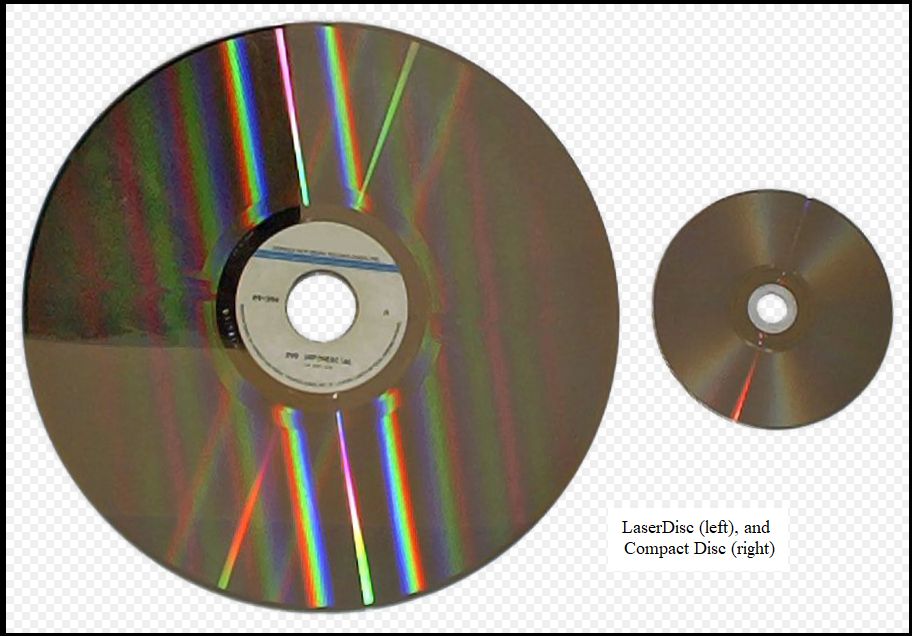
|
|
“Bohemia ruled the World’s Columbian Exposition yesterday. It was the special date set apart for that nationality, and its citizens invaded the White City at every entrance by the thousands,” wrote the reviewer in the Chicago Daily Tribune. On August 12, 1893, 8,000 people packed into the fair’s Festival Hall to hear the Exposition Orchestra—the Chicago Orchestra expanded to 114 players—under the batons of Vojtěch I. Hlaváč, professor of music at the Imperial University in Saint Petersburg, Russia, and the director of New York’s National Conservatory of Music in America, Antonín Dvořák. The Tribune reviewer continued: “As Dvořák walked
out upon the stage a storm of applause greeted him. For nearly two minutes
the old composer [age fifty-one!] stood beside the music rack, baton
in hand, bowing his acknowledgements. The players dropped their instruments
to join in the welcome. Symphony no. 4 in G major [now known as no. 8],
considered a severe test of technical writing as well as playing, was
interpreted brilliantly. The Orchestra caught the spirit and magnetism
of the distinguished leader. The audience sat as if spell-bound. Tremendous
outbursts of applause were given.” On the second half of the program, Dvořák
conducted selections from his Slavonic Dances and closed the program with
his overture My Country. 
|
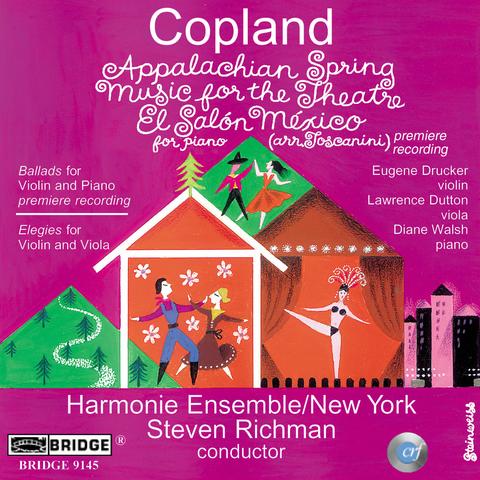 SR: Oh, gosh! I don’t know. I have no answers
to these questions. It’s like when somebody asks me why am I so
interested in putting this statue up, to paraphrase George Mallory, “Because
it ain’t there!” [Laughs] It’s hard to
think about what your interests are. What is my motivation for doing
this? It’s very sad, and it was a travesty that this house was knocked
down. I love Dvořák’s music! It’s very unique; it’s
very warm; it’s very direct. I don’t mean to sound condescending if
I say it’s not complex, but it’s not neurotic the way a lot of other music
is. For lack of a better word, it’s not intellectual. Dvořák
was a great democrat. I’ve been reading his letters, and he was friends
with the caretaker of his estate. He was also friends with Tchaikovsky
and the King of England, but he was friends with very common people.
He saw no divisions between people at all. This is an extremely
bold idea for the time, considering his celebrity. It’s really astounding.
Everything I read about him shows me what a great man he was! The
worst question is who’s your favorite composer? Any musician is
going to say the same thing — the one that I’m working
on at the moment! I become obsessed basically with whoever I’m working
on. I almost become that person. You read everything you can
about him, and get you get totally saturated with him.
SR: Oh, gosh! I don’t know. I have no answers
to these questions. It’s like when somebody asks me why am I so
interested in putting this statue up, to paraphrase George Mallory, “Because
it ain’t there!” [Laughs] It’s hard to
think about what your interests are. What is my motivation for doing
this? It’s very sad, and it was a travesty that this house was knocked
down. I love Dvořák’s music! It’s very unique; it’s
very warm; it’s very direct. I don’t mean to sound condescending if
I say it’s not complex, but it’s not neurotic the way a lot of other music
is. For lack of a better word, it’s not intellectual. Dvořák
was a great democrat. I’ve been reading his letters, and he was friends
with the caretaker of his estate. He was also friends with Tchaikovsky
and the King of England, but he was friends with very common people.
He saw no divisions between people at all. This is an extremely
bold idea for the time, considering his celebrity. It’s really astounding.
Everything I read about him shows me what a great man he was! The
worst question is who’s your favorite composer? Any musician is
going to say the same thing — the one that I’m working
on at the moment! I become obsessed basically with whoever I’m working
on. I almost become that person. You read everything you can
about him, and get you get totally saturated with him.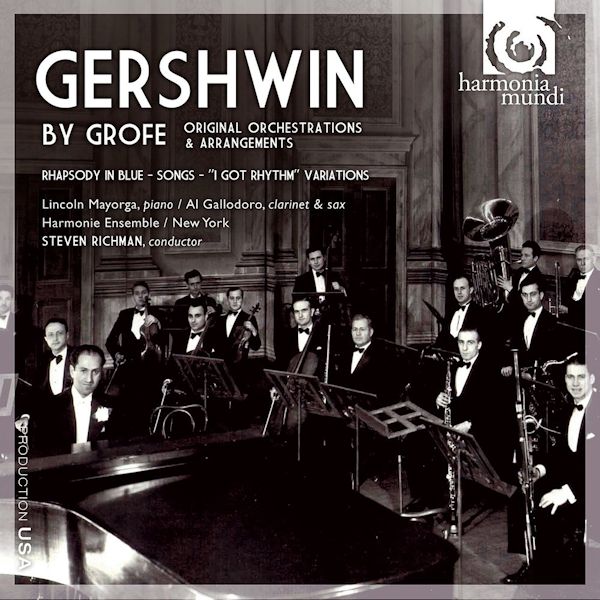 SR: Yes, the Harmonie Ensemble / New York. I founded it
in 1979. Our original core group was a classical wind ensemble
— about a dozen players from Metropolitan Opera Orchestra, the
New York Philharmonic, the New York City Ballet, and a
great pool of freelance players in New York. I just got people together
for a concert in a very old theater that was opened up for concerts in
New York at the time, called Symphony Space, on the opposite side of Manhattan.
I just called up a bunch of my colleagues and said that we’re going to play
the Stravinsky Octet for winds and we’ll do a Dvořák
Wind Serenade. It was January, and in those days January
was a dry month. No longer! Now there’s music 365 days a year,
but in 1979 people had a couple of days off once in a while. So,
we got together and had a few rehearsals. We got a very enthusiastic
response, and started to get some funding, so we immediately begin the orchestral
concerts. One of the things that we did in the second year of our existence
was an eightieth birthday concert for Aaron Copland. Every living American
composer was there! It started at 10 in the morning, and it ended
about half past midnight the next day. There was lots of Copland,
of course, and Copland conducted my orchestra in the chamber version of
Appalachian Spring. I conducted Music for the Theatre,
and it’s been made into two films. There’s a video which has been shown
on PBS in the United States, and on the BBC in England. So we did
a very eclectic mixture of stuff, and that got it lots of birthday concerts
— Stravinsky 100th birthday concert in New York in December
1981, and Leonard Bernstein’s 70th birthday concert at Lincoln Center in
the summer of ’88, at the same time when they were going to the big bash
up at Tanglewood. I did it in New York. He’s from Massachusetts,
but we think of him as in New York boy! So, I just get excited about
things, and I go for it. That’s why I’m interested in Ferde Grofé
and Stravinsky. I’m actually trying to record a lot of the pieces
we’ve performed. We’ve done a lot of premieres of pieces, even a
couple of small Stravinsky premieres I’m intending to record. My
dream is to record the Gershwin orchestrations. I think that would
be wonderful!
SR: Yes, the Harmonie Ensemble / New York. I founded it
in 1979. Our original core group was a classical wind ensemble
— about a dozen players from Metropolitan Opera Orchestra, the
New York Philharmonic, the New York City Ballet, and a
great pool of freelance players in New York. I just got people together
for a concert in a very old theater that was opened up for concerts in
New York at the time, called Symphony Space, on the opposite side of Manhattan.
I just called up a bunch of my colleagues and said that we’re going to play
the Stravinsky Octet for winds and we’ll do a Dvořák
Wind Serenade. It was January, and in those days January
was a dry month. No longer! Now there’s music 365 days a year,
but in 1979 people had a couple of days off once in a while. So,
we got together and had a few rehearsals. We got a very enthusiastic
response, and started to get some funding, so we immediately begin the orchestral
concerts. One of the things that we did in the second year of our existence
was an eightieth birthday concert for Aaron Copland. Every living American
composer was there! It started at 10 in the morning, and it ended
about half past midnight the next day. There was lots of Copland,
of course, and Copland conducted my orchestra in the chamber version of
Appalachian Spring. I conducted Music for the Theatre,
and it’s been made into two films. There’s a video which has been shown
on PBS in the United States, and on the BBC in England. So we did
a very eclectic mixture of stuff, and that got it lots of birthday concerts
— Stravinsky 100th birthday concert in New York in December
1981, and Leonard Bernstein’s 70th birthday concert at Lincoln Center in
the summer of ’88, at the same time when they were going to the big bash
up at Tanglewood. I did it in New York. He’s from Massachusetts,
but we think of him as in New York boy! So, I just get excited about
things, and I go for it. That’s why I’m interested in Ferde Grofé
and Stravinsky. I’m actually trying to record a lot of the pieces
we’ve performed. We’ve done a lot of premieres of pieces, even a
couple of small Stravinsky premieres I’m intending to record. My
dream is to record the Gershwin orchestrations. I think that would
be wonderful! 
© 1996 Bruce Duffie
This conversation was recorded in Chicago on November 7, 1996. Portions were broadcast on WNIB in 1998; and on WNUR in 2003 and 2014. This transcription was made in 2018, and posted on this website at that time. My thanks to British soprano Una Barry for her help in preparing this website presentation.
To see a full list (with links) of interviews which have been transcribed and posted on this website, click here.
Award - winning broadcaster Bruce Duffie was with WNIB, Classical 97 in Chicago from 1975 until its final moment as a classical station in February of 2001. His interviews have also appeared in various magazines and journals since 1980, and he now continues his broadcast series on WNUR-FM.
You are invited to visit his website for more information about his work, including selected transcripts of other interviews, plus a full list of his guests. He would also like to call your attention to the photos and information about his grandfather, who was a pioneer in the automotive field more than a century ago. You may also send him E-Mail with comments, questions and suggestions.